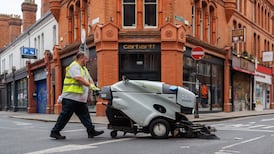AMERICA:The draw of the big city is too strong for immigrants and domestic migrants
A mile west along the K-191 highway you come to a trunca- ted stone pyramid and a pole carrying the US and Kansas flags, a one-room church, a barbecue grill and a scattering of picnic tables. It is quiet, eerily so, covered in a thick fog.
This is the centre of the United States, or at least the geographical centre of the contiguous US or continental 48 states (excluding Alaska and Hawaii). In 1940, a group of engineers, helped by data from the US Coast and Geodetic Society, sought out the exact centre of the country. They found it here.
Well, not exactly here – in fact, it’s a quarter-mile west because Johnny Grieb, a stubborn Kansas farmer, did not want bus-loads of tourists coming and disturbing his hogs. A sign purporting to mark the country’s geographical centre was erected on April 25th, 1940, on the near- pyramid by the local “Hub Club”, away from Grieb’s pigs.
Near the centre of everything is the town of Lebanon, Kansas, where there is next to nothing. There’s a post office, a grocery store, a beauty store and a gun store. Connie Herndon doesn’t allow guns in her office, though; there are signs saying so out front.
As city clerk, she collects the town’s water, sewer and landfill rates, and takes minutes of local meetings. “This town is mainly senior citizens,” she says.
So how does it feel being at the centre of everything? “It’s pretty laid back,” says Debbie Whitten, who is in charge of the post office, a few doors down from Herndon’s office.
Lebanon used to be a very prosperous town, she says, with lots of tourists and well- off farmers, but those days are gone. Tourists used to visit the hotel and coffee shop next to what locals call “the centre”, but the hotel was bought by a hunter from Texas who travels up to shoot deer and pheasant.
“Farms aren’t the small family farms like they used to be; they were bought up by larger farms and the kids have moved away because there are no jobs,” she says.
The local farms haven’t been helped by a drought affecting the local wheat and corn crops for the past two years. “I can’t even tell you the last time it rained,” says Whitten.
The population of Lebanon has been falling steadily over the last two decades, from 364 in 1990 to 303 at the turn of the century. It stands at about 165 today, says Herndon.
The demise of this town, caused by migration to the bigger towns and cities, contrasts sharply with the rush of people into the US seeking employment, while small-town Kansas is a million miles away from the highly charged political debate in Washington over how to reform immigration laws to legalise the 11 million undocumented.
President Barack Obama’s landmark speech in a Las Vegas school on Tuesday pitched immigration reform as one of the goals of his second term, but the finer details still have to be mapped out.
Legislation on this emotive issue must first pass a politically fractured Congress before the thousands of Irish will know whether they can at last attend family weddings or funerals without fear of not being allowed back into the US if they leave.
Despite the restrictions on illegal immigrants, the demand to live in the US is still strong, driven – in Ireland’s case – by the poor employment prospects at home.
Of the 87,000 people who left Ireland in the 12 months to April 2011, 8,600 went to the US, Central Statistics Office figures show – yet the department of homeland security statistics say that just 15,389 permanent resident visas were issued to Irish people between 2002 and 2011. This was about a 10th of 1 per cent of all permanent visas issued by the US during this period.
Internally within the 50 states, migration trends show that people are leaving the northeastern and midwestern US, including Kansas, for the south and the west, according to US census data.
Texas and Florida have attracted the largest number of domestic migrants over the past decade, with Dallas, Houston, Austin and Miami among the top five metropolitan areas for population growth by migration.
North Dakota has experienced a population surge in recent years owing to the state’s oil boom. For areas such as northern Kansas the demographic picture is as bleak as its landscape. The 2010 census showed that just 16 per cent of the US population live in rural areas, compared with 72 per cent a century ago.
The draw of the big city is still too strong for small-town America and, for the former young residents of Lebanon, being at the centre of everything wasn’t what it was once cracked up to be.









